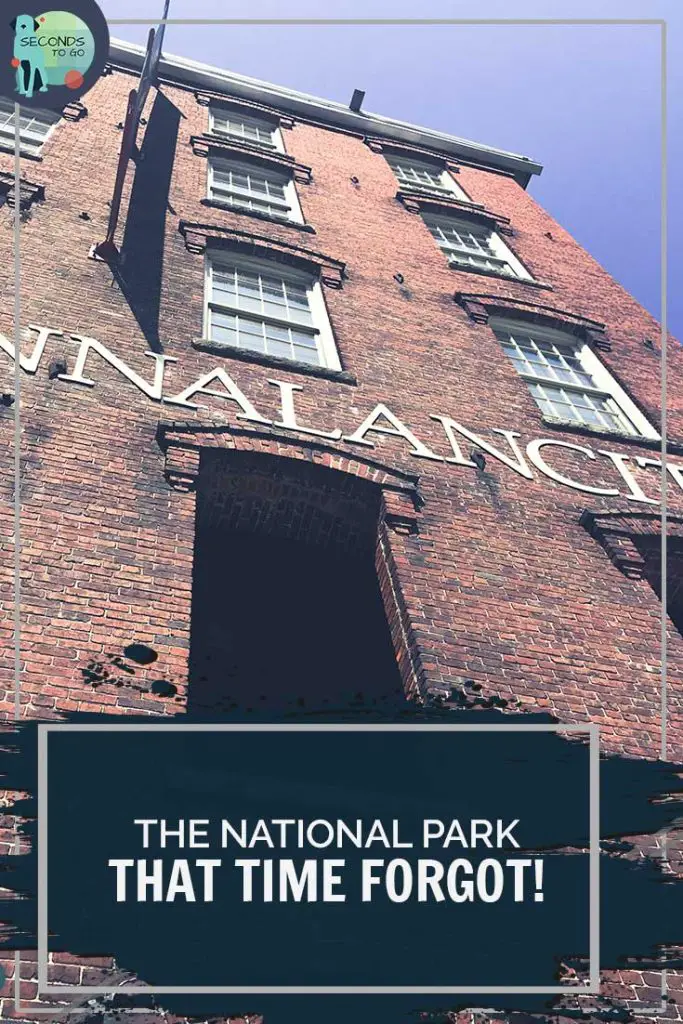On a breezy summer day, Brenton Point State Park in Newport, Rhode Island glistens as brightly as the sun off the ocean waves across the street. Kites fly high, and if you time it right, you might even score a Dell’s Lemonade, one of Rhode Island’s distinctive treats.
However, Brenton Point State Park holds a secret from Newport’s gilded past, and it’s hiding in plain sight.
Exploring Newport’s Gilded Age Past

I first visited Brenton Point State Park on a waning summer day. Kids had gone back to school and vacation season was winding down.
A persistent cloud cover was keeping the unusually muggy temperatures at bay but not stopping picnic-goers and ocean watchers from crowding the parking lot and lawn. I, however, was on a different mission, to find the remains of a gilded-age mansion known as The Reef.
It’s no secret that Newport was once the playground for the New York elite. As the industrial revolution roared across the U.S. from the end of the 18th century and into the early 19th century, the country’s largely agrarian society was transformed into an urban economy.
Textile mills were the first to develop modern manufacturing methods, but the technology was soon brought into other industries, fueling the age of the machine. Soon, outlying residents, immigrants and new arrivals seeking their fortune in manufacturing were flooding into New York City and other urban areas.
The U.S. economy was growing at its fastest rate in history, and for a select few, industry and invention turned into great wealth. Soon old-money family names, such as Griswold, Du Pont and Forbes, were joined by an emerging rank of upstarts like the Vanderbilts, Belmonts and Berwinds.
It is estimated by some historical references that there were as many as 4,000 millionaires living in America by the late 1800s, many of them seeking admittance into New York “fashionable society”.
The well-known matron of wealth and privilege, Mrs. Lina Astor, attempted to protect the borders of the wealthy domain by establishing rules for proper society. Her cousin, Ward McAllister, even went so far as to say that there were only 400 of the wealthy New York residents who were fit for polite society. As a result, these elitists who lined Newport’s shores with gilded-age empires, were appropriately coined the 400.
As one wealthy tycoon after another built opulent summer “cottages” on Newport’s ancient shores, each tried to outdo the other on extravagance. A look inside Breakers, built by the Vanderbilt family in 1895, reveals stone and alabaster walls and columns fitted with gold and crystal. Nearby at The Elms, original artwork, Chinese lacquer panels and specially designed tapestries adorn the walls, while the Marble House, appropriately named, contains 500,000 cubic feet of marble and a Chinese tea house overlooking the sea.
It was Mark Twain who coined the term “gilded age”, pointing out in his humorous way the great dived between the wealth of The 400 and the lower classes that made the factories and mansions run. It was this divide that would eventually spell change for Newport society and the grand homes once built to host their social escapades.
As wealth spread more evenly across the country, subsequent generations found the Grand Dames difficult to maintain from both a financial standpoint and a practical one. With a growing middle class, servants were in short supply. Without servants, it was difficult to keep the large buildings alive.
By the 1930s, Newport’s historical mansions were falling at an alarming rate. Contents were auctioned and buildings razed. Some were sold and transformed into apartments or public facilities. Others were left derelict to rot and decay.
As important architectural history of the gilded age began to vanish, The Preservation Society of Newport County was born, to save properties such as the then vacant Bella Rosa and The Elms.
However, due to the sheer number of properties, not all could be salvaged, and that’s the legacy of The Reef at Brenton Point State Park.
Brenton Point State Park’s Gilded Age Past
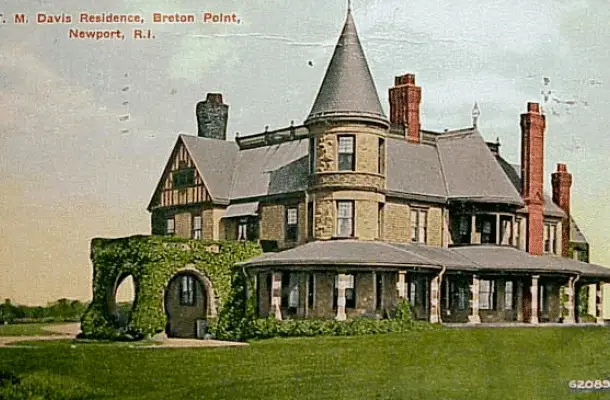
In 1885, copper magnate, Theodore M. Davis built The Reef, a Queen Anne villa on 18 acres overlooking the Atlantic Ocean. Constructed partly of stone, the shingle-style mansion was at home on the rocky shore, taking up a large portion of what is now Bretton Point State Park.
The great monument to the Gilded Age was designed by The Boston architectural firm of Sturgis & Brigham and created to house Davis’ extensive art collection. Davis was heralded as an author, collector and well-known Egyptologist, credited with discovering 6 major tombs on special archeological license from the Egyptian government.
The Reef was equal parts home and museum. Several of Davis’ Egyptian artifacts made it back to his Newport mansion, joining many priceless works of art. While his Egypt collection can now be viewed at the Cairo Museum, the fate for the The Reef was not so favorable.
Upon Davis’ death in 1915, the house was purchased by Mr. and Mrs. Milton J. Budlong (possibly not the most upstanding of fellows) and renamed The Bells. During a difficult divorce dispute between the Budlongs, the home was placed in contention. Neither Budlong ever lived in the house again.
Alone and uninhabited on its prime 18 acres of Atlantic Coast, the property eventually passed to Miss Frances Budlong, who showed as little interest in the estate as did her predecessors. It was seized during the second World War and gun battlements were installed to augment the fortifications at nearby Fort Wetherill. If you look, you can still find the old foundations scattered around Brenton Point State Park.
As the war drew to a close and American shores were secure again, the property was returned to Miss Budlong who continued to ignore the house and acreage, leaving it open to teenage vandalism and decay.
In 1961, vandals set fire to the historic structure, razing another piece of Newport’s fragile Gilded-Age History.
Brenton Point State Park, Exploring What Remains Today

While enjoying a breezy summer day at Brenton Point state park, you might take respite in the visitor’s center. If you only stop to use the restrooms, you’ll probably never realize that you’ve just entered a part of the great estate.
The stone building overlooking the grassy slope of Brenton Point State Park once housed the mansion’s servants as well as the laundry facility. Servants were integral to the Gilded-Age estates, whose operation depended upon a magical orchestration of events to rival even Disney World today.
Staff hierarchies determined pay and amenities. The more visible a staff member, the better the pay.
For example, the Chef was at the pinnacle of the servant pyramid. At the Elms, one of the surviving Newport mansions not far from Brenton Point State Park, the Chef was paid $10,000 a year, working 7 days a week. Scullery maids, on the other hand, lived at the pyramid base, receiving $500 a year plus living quarters. They worked 7 days a week, on call 24 hours a day, except for one evening and one afternoon a week.
At The Reef, a similar servant hierarchy was likely in effect. We can get an idea of both the size of the original house as well as the number of servants employed by slipping behind the stone wall beside the laundry house and following a carriage trail back to the stables.
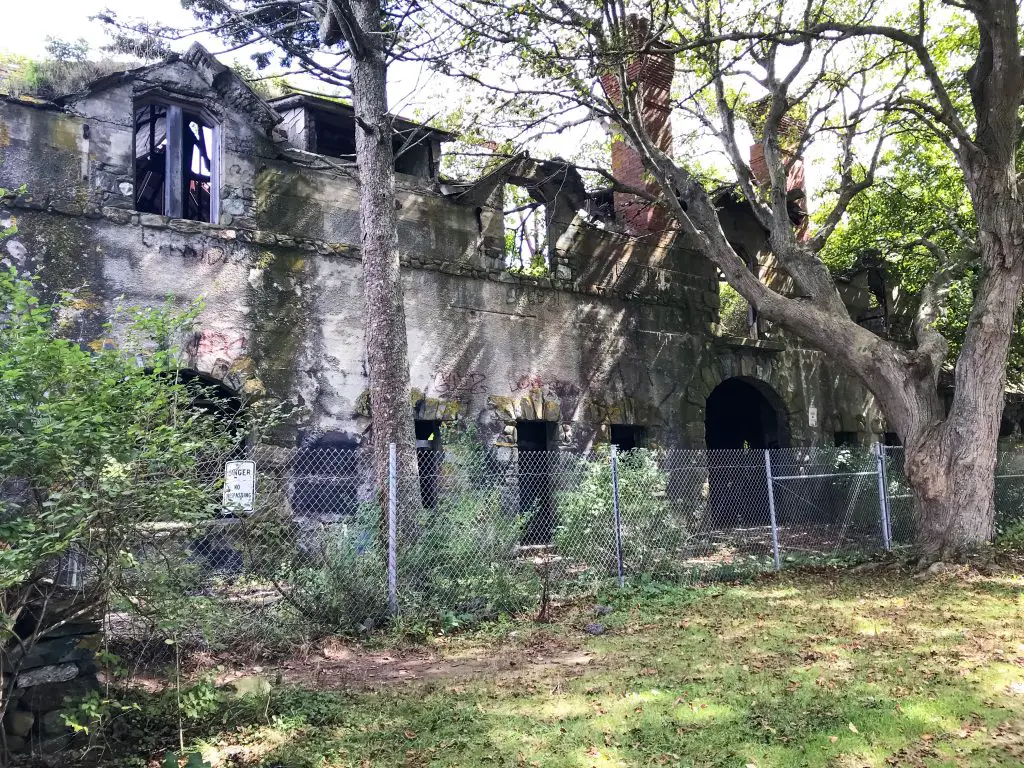
Here, the stable clings to life with slippery fingertips. Roof supports are rusted and sagging while concrete floors are disintegrating in the corrosive ocean air. Crumbling and accosted with unflattering graffiti, the remains have been walled off from further abuse by a chain link fence.
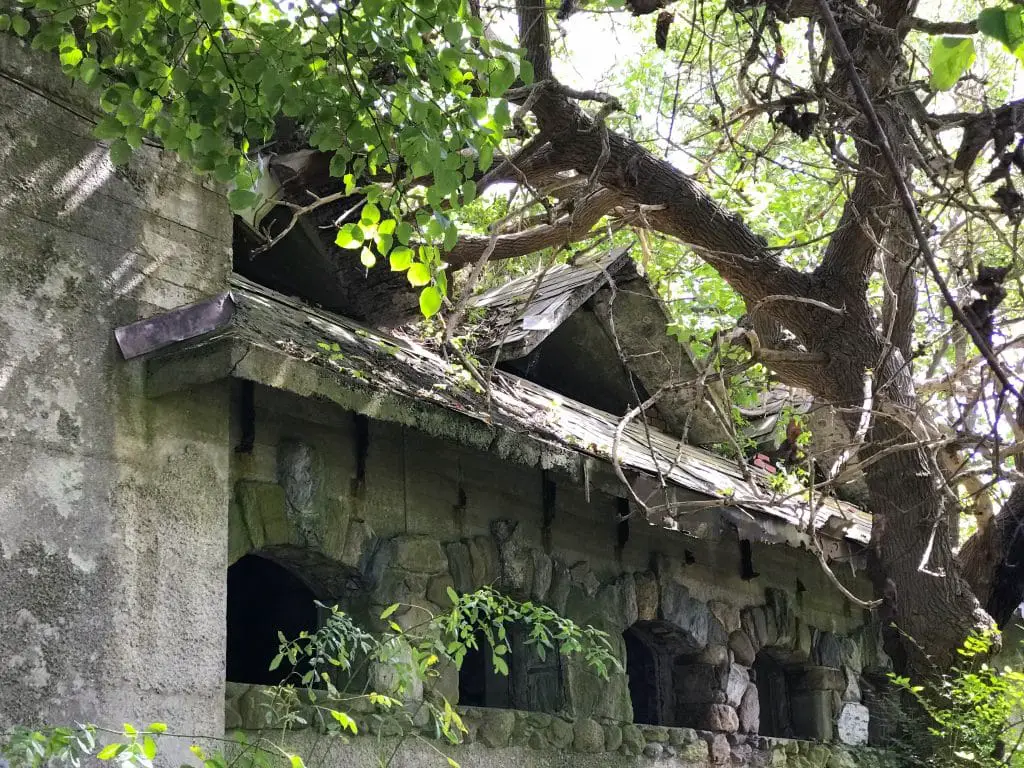
Although invasive vines and trees threaten to cover the structure at Brenton Point State Park, for now, it’s easy to get a feel for the size of the place, giving us a glimpse into the splendor of the house it served. In its day, the stable would have been a hive of activity, employing and housing several coachman, grooms and trainers. More than a few horses and carriages would have also been kept within the walls.
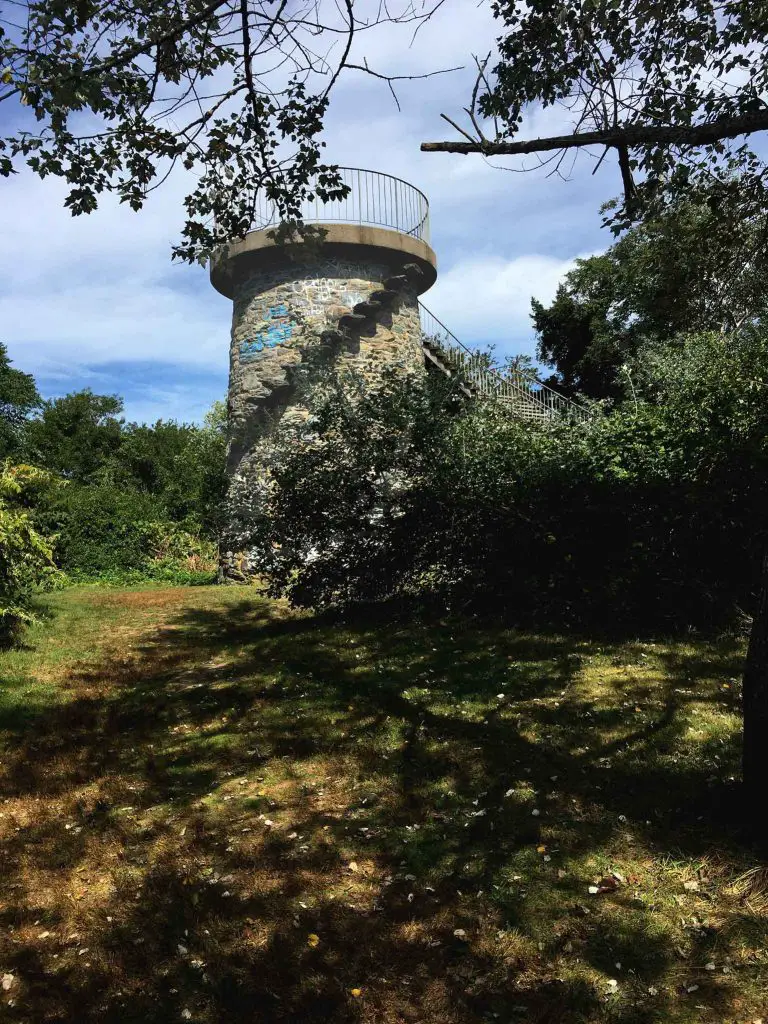
You can get a pretty good look at the stable from the carriage drive, but for a bird’s eye view, follow the fence around to the rear of the stable. Here, you can climb the stairs of a platform beside a stone tower for a different perspective and a greater appreciation of the size of the building. You’ll also get something of a view of Bretton Point State Park.
Just be careful, as several steps were rotting or missing on our first visit to this area. During a subsequent visit, the missing stairs had been replaced, but some questionable boards remained.
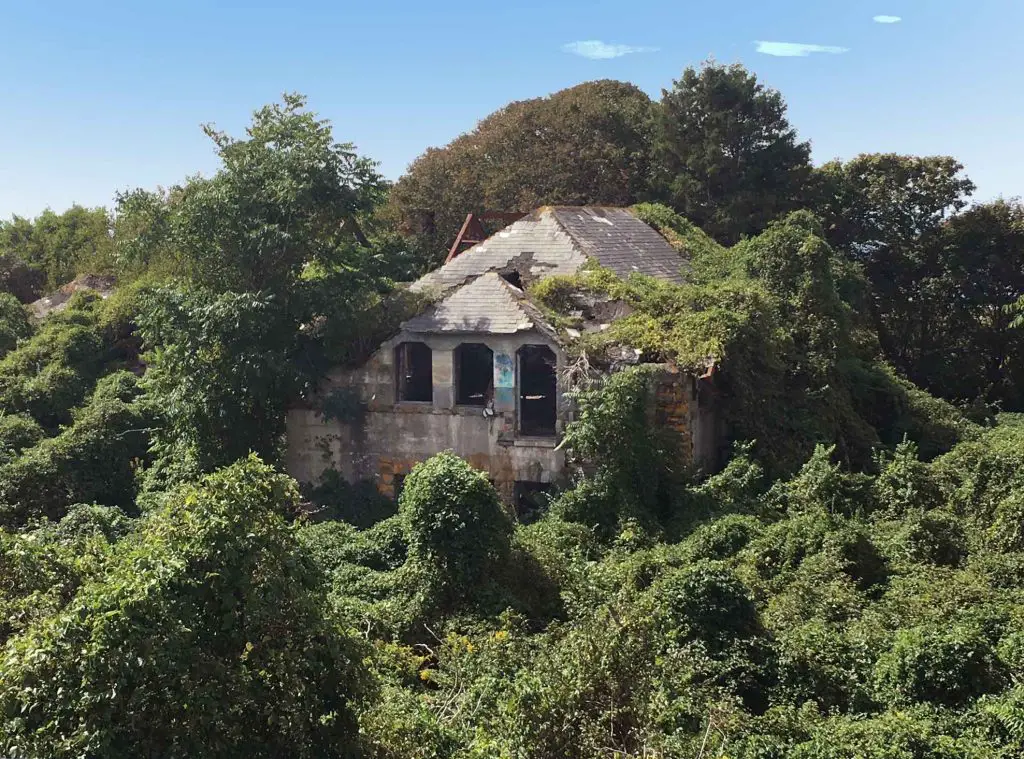
Demise of the Reefs Carriage House Now Certain
Say it was only a matter of time or blame it on the nonsensical actions of youth, but the seal has been set on the demolition of the Reefs carriage house, one of the few surviving structures of the once great estate. Rhode Island Department of Environmental Management (RIDEM) made the decision to tear down the structure after a teenager was injured in 2023 from a fall through the roof, after trespassing the fence that surrounds what is left of the establishment.
AA Wrecking and Asbestos Abatement Co. was engaged to conduct the demolition at a reported contract price of $293,800, but initial efforts were delayed, first due to an exceptionally rainy and stormy summer in 2023. Later efforts were also stalled in February of 2024 due to equipment failure.
Why Preserve Newport’s Heritage?
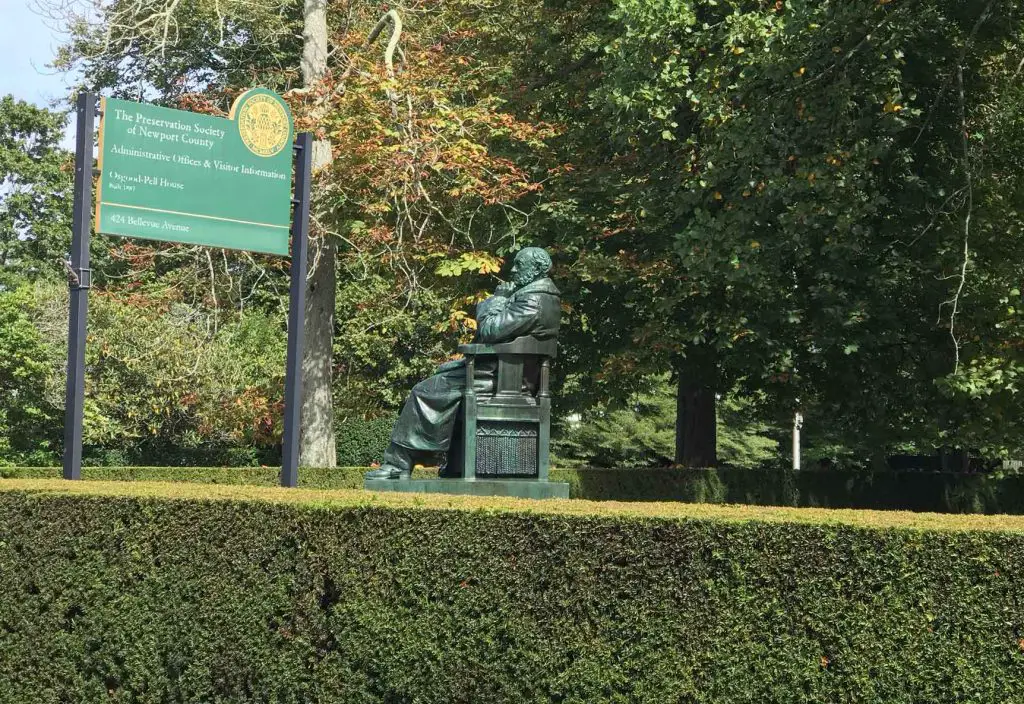
While the remains of The Reef continue to decay at Brenton Point State Park, the Gilded-Age party continues across several Newport Mansions. Regular self-guided tours are offered at properties such as Breakers and The Elms, thanks to the Preservation Society of Newport County.
Early members foresaw the need to hold onto our architectural history as well as the societal contradictions of the Gilded Age. After all, as George Santayana said (later paraphrased and made famous by Winston Churchill), “Those who cannot remember the past are condemned to repeat it.”
Visiting Brenton Point State Park
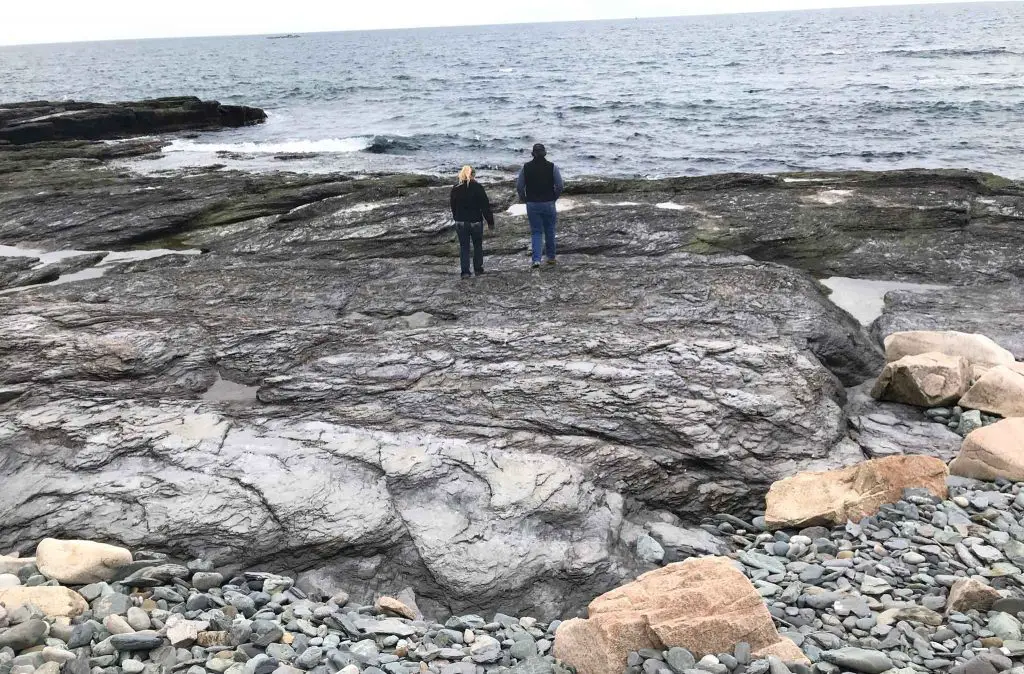
Despite its Gilded-Age heritage, Brenton Point State Park may be best known today for kite flying. Thanks to a steady ocean breeze, the location is home to the Newport Kite Festival.
After exploring the remains of The Reef stables, grab a picnic lunch and settle in to watch sport kites fly high. It may be the only time you’ll see a giant whale floating above your head or watch a Batman-faced squid make a sudden dive to the ground.
Daily activities include picnicking, fishing, listening to the waves, feeling the ocean breezes and watching the sun set. Swimming here is not recommended due to the rocky coast.
Brenton Point State Park is located on Ocean Drive in Newport and is open year round sunrise to sunset.

LOCATION
Newport, RI

TRIP LENGTH
1-6 hours




